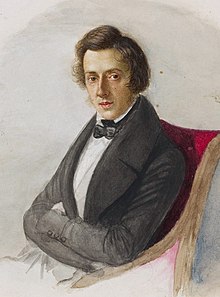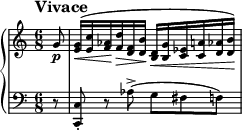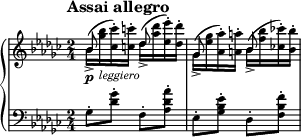|
Études (Chopin) The Études by Frédéric Chopin are three sets of études (solo studies) for the piano published during the 1830s. There are twenty-seven compositions overall, comprising two separate collections of twelve, numbered Op. 10 and Op. 25, and a set of three without opus number.[1] HistoryCompositionChopin's Études formed the foundation for what was then a revolutionary playing style for the piano. They are some of the most challenging and evocative pieces of all the works in concert piano repertoire. Because of this, the music remains popular and often performed in both concert and private stages.[2] Some are so popular they have been given nicknames; among the most popular are Op. 10, No. 3, sometimes identified by the names Tristesse ("Sadness") or "Farewell" (L'Adieu), as well as the "Revolutionary Étude" (Op. 10, No. 12), “Black Keys” (Op. 10, No. 5), and "Winter Wind" (Op. 25, No. 11). No nicknames are of Chopin's original creation.[2] All twenty-seven études were published during Chopin's lifetime; Op. 10, the first group of twelve, were composed between 1829 and 1832, and were published in 1833, in France, Germany, and England. The twelve études of Op. 25 were composed at various times between 1832 and 1835, and were published in the same countries in 1837. The final three, part of a series called Méthode des méthodes de piano compiled by Ignaz Moscheles and François-Joseph Fétis, were composed in 1839, without an assigned opus number. They appeared in Germany and France in November 1840, and England in January 1841.[2] Accompanying copies of these important early editions, there are usually several manuscripts of a single étude in Chopin's own hand, and additional copies made by his close friend, Jules Fontana, along with editions of Karol Mikuli, Chopin's student.[2] The first études of the Opus 10 set were written when Chopin was a teenager. They rank alongside the early works of Felix Mendelssohn as rare examples of extremely youthful compositions that are regarded as both innovative and worthy of inclusion in the standard canon. Chopin's études elevated the musical form from purely utilitarian exercises to great artistic masterpieces.[3] ImpactAlthough sets of exercises for piano had been common from the end of the 18th century (Muzio Clementi, Johann Baptist Cramer, Ignaz Moscheles, and Carl Czerny were composers of the most significant), Chopin's Études not only presented an entirely new set of technical challenges, but were the first to become a regular part of the concert repertoire. His études combine musical substance and technical challenge to form a complete artistic form.[4] They are often held in high regard as the product of mastery of combining the two. His effect on contemporaries such as Franz Liszt was apparent, based on the revision Liszt made to his series of concert études after meeting Chopin. Other great composers after him, such as Schumann, Debussy, Prokofiev, and Rachmaninoff, wrote études in the same style as Chopin's.[5] Contemporary Polish musicologist Tadeusz A. Zieliński wrote, on Op. 10, that "not only did they become an orderly demonstration of a new piano style and the formulas peculiar to it, but also an artistic ennoblement of this style."[6] Chopin's Études are not without modern influence as well. Several of the études have lodged themselves in popular music, movies, or television shows. List of ÉtudesÉtudes Op. 10The first set of Études was published in 1833 (although some had been written as early as 1829). Chopin was twenty-three years old and already famous as a composer and pianist in the salons of Paris, where he made the acquaintance of Franz Liszt. Subsequently, Chopin dedicated the entire opus to him – "à mon ami Franz Liszt" (to my friend, Franz Liszt). The etudes 8, 9, 10 and 11 date from October/November 1829, nos. 5 and 6 probably from summer 1830, nos. 1 and 2 from November 2, 1830, no. 12 from September 1831 (?), no. 7 from spring 1832, no. 4 from August 6, 1832, and no. 3 from August 25, 1832 (Paris) (Krystyna Kobylańska).[full citation needed]
Études Op. 25Chopin's second set of Études was published in 1837, and dedicated to Franz Liszt's mistress, Marie d'Agoult, the reasons for which are a matter of speculation. The date of composition of all opus 25 Etudes is before June 30, 1835, the date of a contract between Chopin and Breitkopf & Hartel (awarding the publisher the rights for Germany) (Krystyna Kobylanska).
Trois nouvelles étudesTrois nouvelles études were written in 1839 as a contribution to Méthode des méthodes de piano, a piano instruction book by Ignaz Moscheles and François-Joseph Fétis, and were not given a separate opus number. While less technically brilliant than those of Op. 10 and 25, these three études nevertheless retain Chopin's original formula for harmonic and structural balance.
Technical aspects and student guidesChopin's Études are technically demanding, and require players to have significant experience with speed, arpeggios, and trills even in weaker fingers.[7] For all études
For selected études
Paraphrases
See alsoReferences
Further reading
External linksWikimedia Commons has media related to Études by Frédéric Chopin. Analysis and scores]
Performances |




![\new PianoStaff <<
\new Staff = "Up" \with { \magnifyStaff #3/4 } <<
\new Voice \relative c' {
\clef treble
\tempo "Vivace"
\set Score.tempoHideNote = ##t \tempo 4 = 116
\time 2/4
\key ges \major
\ottava #1
\override TupletBracket.bracket-visibility = #'if-no-beam
\tuplet 3/2 8 {ges'''16^\markup{\italic brilliante} ([bes des,] ges ees ges des [ges bes,] des ges, bes}
\ottava #0
\omit TupletNumber
\tuplet 3/2 8 {ges16 [bes des,] ges ees ges des [ges bes,] des ges, bes)}
}
>>
\new Staff = "Down" \with { \magnifyStaff #3/4 } <<
\new Voice \relative c{
\clef bass
\key ges \major
\dynamicUp
<ges' bes des ges>8-. \f [<ges ces ees ges>-. <ges bes des ges>-.] r <ges, ges'>-. \p \sustainOn <ces' ees ges>-. \sustainOff [<bes des ges>-.] r
}
>>
>>](http://upload.wikimedia.org/score/r/a/rac8ztkkj85d9uaodvcntvocmhqiz4j/rac8ztkk.png)




![\new PianoStaff <<
\new Staff = "Up" \with { \magnifyStaff #3/4 } <<
\new Voice \relative c' {
\clef treble
\tempo "Vivace assai"
\set Score.tempoHideNote = ##t \tempo 4. = 152
\time 12/8
\key aes \major
\partial 8
ees8 aes_\markup{\italic dolce} \(<c aes'> (bes) <des bes'>-> (b) <d b'> (c) <ees c'> (cis) <e cis'>-> (d) <f d'> (\hide r8)\)
}
>>
\new Staff = "Down" \with { \magnifyStaff #3/4 } <<
\new Voice \relative c{
\clef bass
\key aes \major
\stemDown
\mergeDifferentlyHeadedOn
r8 aes_\markup{\italic legato} \sustainOn ([c' aes ees ees' aes,]) aes, ([c' aes ees ees' aes, \sustainOff ])
}
\new Voice \relative c{
\stemUp
s8 s4. ees2 s4 ees2
}
>>
>>](http://upload.wikimedia.org/score/3/f/3fviz8aiqponx41dw0h7pur43zdh1w9/3fviz8ai.png)



![\new PianoStaff <<
\new Staff = "Up" \with { \magnifyStaff #3/4 } <<
\new Voice \relative c' {
\clef treble
\tempo "Presto"
\set Score.tempoHideNote = ##t \tempo 2 = 112
\key f \minor
\time 2/2
\partial 4
\override TupletBracket.bracket-visibility = #'if-no-beam
\tupletSpan 4
c'4 \p (\tuplet 3/2 {c8_\markup{\italic molto \italic legato} [des b] c ees des c [des b!] c fis g}
\omit TupletNumber
\tuplet 3/2 {c, [des b] c ees des c [des b] c aes' f} \hide r16)
}
>>
\new Staff = "Down" \with { \magnifyStaff #3/4 } <<
\new Voice \relative c{
\clef bass
\key f \minor
\tupletSpan 2
r4 \tuplet 3/2 {e \sustainOn (g' c,) bes! (g' c, \sustainOff) f, \sustainOn (aes' c,) aes (aes' c, \sustainOff)} s16
}
>>
>>](http://upload.wikimedia.org/score/c/9/c9ppp17yi9xp1uupb36nl79fjszrdaw/c9ppp17y.png)
![\new PianoStaff <<
\new Staff = "Up" \with { \magnifyStaff #3/4 } <<
\new Voice \relative c' {
\clef treble
\tempo "Allegro"
\set Score.tempoHideNote = ##t \tempo 4 = 120
\key f \major
\time 3/4
\partial 4
\stemDown
c'4 _(f,8_\markup{\italic leggiero} [f']) c,_([c']) f,_(f') g,_([g']) c,,_([c']) g_(g')
}
\new Voice \relative c'{
\stemUp
s4 d'16 c8. g16 f8. d'16 c8. d16 c8. a16 g8. d'16 c8.
}
>>
\new Staff = "Down" \with { \magnifyStaff #3/4 } <<
\new Voice \relative c{
\clef bass
\key f \major
\stemDown \dynamicUp
r4 \p c8 \sustainOn_([f, \sustainOff]) c' \sustainOn_([f, \sustainOff]) c' \sustainOn_([f, \sustainOff]) c' \sustainOn_([f, \sustainOff]) c' \sustainOn_([f, \sustainOff]) c' \sustainOn_([f, \sustainOff])
}
\new Voice \relative c{
\stemUp
s4 a'16 [f] s8 a16 [f] s8 a16 [f] s8 bes16 [e,] s8 bes'16 [e,] s8 bes'16 [e,]
}
>>
>>](http://upload.wikimedia.org/score/f/u/fuu4knjlersdfafjh11h05j9ho00p5x/fuu4knjl.png)
![\new PianoStaff <<
\new Staff = "Up" \with { \magnifyStaff #3/4 } <<
\new Voice \relative c' {
\clef treble
\tempo "Agitato"
\set Score.tempoHideNote = ##t \tempo 4 = 160
\key a \minor
\time 2/2
\partial 4
r4 r8 <e a e'>-! r <a e' a>-! r <a d a'>-! r <gis e' gis>-!
}
>>
\new Staff = "Down" \with { \magnifyStaff #3/4 } <<
\new Voice \relative c{
\clef bass
\key a \minor
\dynamicUp
e4-> (a,8-! \p) [<e' a>-!] c-! <a' e'>-! b,-! [<f' d>-!] e-! <b' e>-!
}
>>
>>](http://upload.wikimedia.org/score/s/v/sv5ljaqrubl2nct2kqch5nfvmuui6mm/sv5ljaqr.png)

![\new PianoStaff <<
\new Staff = "Up" \with { \magnifyStaff #3/4 } <<
\new Voice \relative c' {
\clef treble
\tempo "Allegro"
\set Score.tempoHideNote = ##t \tempo 2 = 69
\key gis \minor
\time 2/2
<b' dis>16_\markup{\italic sotto \italic voce} ([<cis e> <b dis> <cis e>] <b dis> <cis e> <b dis> <cis e> <b dis> [<cis e> <b dis> <cis e>] <b dis> <cis e> <b dis> <cis e> \hide r16)
}
>>
\new Staff = "Down" \with { \magnifyStaff #3/4 } <<
\new Voice \relative c{
\clef bass
\key gis \minor
R1 s16
}
>>
>>](http://upload.wikimedia.org/score/3/l/3luxc7zckxsfouoban4h98auuweuesu/3luxc7zc.png)
![\new PianoStaff <<
\new Staff = "Up" \with { \magnifyStaff #3/4 } <<
\new Voice \relative c' {
\clef treble
\key cis \minor
\override Score.TimeSignature.stencil = ##f
\tempo "Lento"
\set Score.tempoHideNote = ##t \tempo 4 = 40
\time 10/4
s2 s1 r
\revert Score.TimeSignature.stencil
\bar "||"
\time 3/4
}
>>
\new Staff = "Down" \with { \magnifyStaff #3/4 } <<
\new Voice \relative c{
\clef bass
\key cis \minor
\dynamicUp
gis4 \p \< (dis'4. \! cis8 \> cis [bis \!] a'4. gis8 fisis16 \< gis a gis \! b \> a e eis fis eis gis fis a gis cis, dis \!)
}
>>
>>](http://upload.wikimedia.org/score/s/5/s5khn93x7ecugduuxogs61xtbjcnxut/s5khn93x.png)
![\new PianoStaff <<
\new Staff = "Up" \with { \magnifyStaff #3/4 } <<
\new Voice \relative c' {
\clef treble
\key des \major
\tempo "Vivace"
\set Score.tempoHideNote = ##t \tempo 2 = 69
\time 2/2
\tupletSpan 4
\stemUp
\override TupletNumber.Y-offset = #-3
\override TupletNumber.X-offset = #3
\tuplet 3/2 {<ges' ees'>8_\markup{\italic molto \italic legato}^([<aes f'> <ges ees'>] <aes f'> <ges ees'> <aes f'> <f des'> [<ges ees'> <g e'>] <bes ges'!> <aes f'> <f des'>)}
}
>>
\new Staff = "Down" \with { \magnifyStaff #3/4 } <<
\new Voice \relative c{
\clef bass
\key des \major
\omit TupletNumber
\omit TupletBracket
\tuplet 3/2 {aes,8-.^\markup{\italic messa \italic voce} \sustainOn <c' aes'> ([<ees c'>] <aes ees'> <ees c'> <c aes'> \sustainOff) des,-. \sustainOn <des' aes'> ([<f des'>] <des aes'> <f des'> <des aes'> \sustainOff)}
}
>>
>>](http://upload.wikimedia.org/score/c/i/ciu0qz8lqixy1xpx8kp7maud94nlbyk/ciu0qz8l.png)

![\new PianoStaff <<
\new Staff = "Up" \with { \magnifyStaff #3/4 } <<
\new Voice \relative c' {
\clef treble
\key b \minor
\tempo "Allegro con fuoco"
\set Score.tempoHideNote = ##t \tempo 2 = 72
\time 2/2
\tupletSpan 4
\omit TupletBracket
\tuplet 3/2 {<fis, fis'>8 \p ^(_\([<eis eis'> <fis fis'>] <g g'> <gis gis'> <a a'>\) <gis gis'>_\markup{\italic cresc. \italic poco \italic a \italic poco} _\([<fisis fisis'> <gis gis'>] <a a'> <ais ais'> <b b'>\)} \hide r16)
}
>>
\new Staff = "Down" \with { \magnifyStaff #3/4 } <<
\new Voice \relative c{
\clef bass
\key b \minor
\tupletSpan 4
\omit TupletBracket
\tuplet 3/2 {<fis,, fis'>8 _\([<eis eis'> <fis fis'>] <g g'> <gis gis'> <a a'>\) <gis gis'> _\([<fisis fisis'> <gis gis'>] <a a'> <ais ais'> <b b'>\)} s16
}
>>
>>](http://upload.wikimedia.org/score/3/p/3pya0osjvsivsaxuqsa3gl30qsvzkko/3pya0osj.png)

![\new PianoStaff <<
\new Staff = "Up" \with { \magnifyStaff #3/4 } <<
\new Voice \relative c' {
\clef treble
\key c \minor
\override Score.MetronomeMark.Y-offset = #10
\tempo "Molto allegro con fuoco"
\set Score.tempoHideNote = ##t \tempo 2 = 80
\time 2/2
\stemUp
\change Staff = "Down"
ees,16^> \f ^([g
\change Staff = "Up"
ees' ees] g ees' ees g ees'^> [g, ees ees] g, ees ees
\change Staff = "Down"
g,)
}
>>
\new Staff = "Down" \with { \magnifyStaff #3/4 } <<
\new Voice \relative c{
\clef bass
\key c \minor
\stemDown
c,16 \sustainOn [g' c c] g' c c
\change Staff = "Up"
g' c [g
\change Staff = "Down" c, c] g c, c g \sustainOff
}
>>
>>](http://upload.wikimedia.org/score/6/r/6rseirngrpoqtokvma9wd1qw4phpdr8/6rseirng.png)


